Bid begins for Jules Verne Trophy record
Published on January 10th, 2021
The six crew of the 32-metre trimaran Edmond de Rothschild set sail January 10 at 01 hours 33 minutes and 46 seconds UTC on a fresh attempt at the Jules Verne Trophy record. Setting off the race start line off the island of Ushant, the team of Franck Cammas, Charles Caudrelier, Morgan Lagravière, David Boileau, Yann Riou and Erwan Israël seek to beat the round the world record of 40:23:30 set in 2017 by Francis Joyon and the crew of Idec Sport.
After a failed first attempt that lasted just three days in November 2020, to beat the record and become the 10th team to etch its name on this monument to offshore racing, they must recross the start line prior to February 20 at 00 hours 3 minutes and 15 seconds UTC.
After the early start, by afternoon the crew had already devoured the Bay of Biscay and were rounding the north-west tip of Spain and with it the renowned and dreaded Cape Finisterre. As forecast, the NE’ly breeze has fleshed out throughout the day and is currently dishing up in excess of 30 knots with the sea building.
Once along the length of the Iberian peninsula, everything will already be about compromise and the crew will have to thread its way along a narrow corridor of breeze to gain southing, whilst ensuring they are neither too close to the coast where the wind could run out of puff, nor too far offshore where they may be subject to heavy seas that do little to benefit speed.
The real difficulty of this start of the Jules Verne Trophy attempt is to try to pinpoint and then get a handle on the highly decisive weather sequence between the north and south so as to get down to the southern latitudes as quickly as possible.
To do this, the Cammas-Caudrelier pairing and their four crew know that they must be precise in their trajectory if they are to keep pace with the tempo set by the weather pattern. According to the latest routing, the passage times for the first third of the course are promising. The equator is accessible within a sub-5-day time and Cape Agulhas could be in their wake in under 12 days.
“We’re delighted to have this fine window opening ahead of us,” said Cammas before the start. “It’s our second attempt and we’re approaching it with a great deal more hope than the first. After the start, we have 24 hours with quite a lot of breeze and some manœuvres, especially around Cape Finisterre, before we hook onto the trade wind.”
Added Caudrelier, “It was a bit of a long wait. At Christmas, when the window closed back up, we were a bit worried. We could have set sail two or three days ago as the North Atlantic was very good, however, the South Atlantic remained very average. We’ve tried to combine the two, which isn’t easy as there is still a degree of uncertainty.
“Again it’s not perfect, but we’re into January and we’ve rarely had such a good window. Our first attempt had the benefit of enabling us to get out sailing together in some boisterous conditions. Beyond the performance element, we’ve made gains in reliability and that is essential for beating this record, which will be very hard to achieve.
“This will be my third crewed round the world following on from two Volvo Ocean Races, but the first one in record mode. It’s a whole new adventure and I’m delighted to get the opportunity to experience it and I realize just how lucky we are to be able to live out our dreams.”
Team information – Tracker – Facebook
Crew list:
Franck Cammas and Charles Caudrelier, skippers
David Boileau, trimmer/bowman
Erwan Israël, helm/trimmer
Morgan Lagravière, helm/trimmer
Yann Riou, trimmer/media man
Source: Gitana Team
The rules for the Jules Verne Trophy are simple – it is for the fastest time around the world by any type of yacht with no restrictions on the size of the crew, starting and finishing from the exact line between the Le Créac’h Lighthouse off the tip of Brittany and the Lizard Point in Cornwall. It was first won in 1993, with all nine winners as either catamarans or trimarans. The current challenge is to beat the record time of 40 days 23 hours 30 minutes and 30 seconds set by Francis Joyon and crew on the 31.5m IDEC Sport in 2017.
Record Facts
• Start and finish: a line between Créac’h lighthouse (Isle of Ushant) and Lizard Point (England)
• Course: non-stop around-the-world tour racing without outside assistance via the three Capes (Good Hope, Leeuwin and Horn)
• Minimum distance: 21,600 nautical miles (40,000 kilometres)
• Ratification: World Sailing Speed Record Council, www.sailspeedrecords.com
• Time to beat: 40 days, 23 hours, 30 minutes and 30 seconds
• Average speed: 21.96 knots
• Date of current record: January 2017
• Holder: IDEC SPORT, Francis Joyon and a 5-man crew
Split Time References – Full Crew:
Ushant-Equator: 4d 20h 07 ‘(Spindrift 2 in 2019)
Equator-Cape Aiguilles: 6d 08h 55 ‘(Banque Populaire V in 2012)
Cape Aiguilles-Cape Leeuwin: 4d 09h 32 ‘(IDEC Sport in 2017)
Cape Leuuwin-Cape Horn: 9d 08h 46 ‘(IDEC Sport in 2017)
Cape Horn-Equator: 7d 04h 27 ‘(Banque Populaire V in 2012)
Equator-Ushant: 5d 19h 21 ‘(IDEC Sport in 2017)
Here are the nine that have held the trophy:
2017 – Francis Joyon / IDEC SPORT (31.5m) – 40:23:30:30
2012 – Loïck Peyron / Banque Populaire V (40m) – 45:13:42:53
2010 – Franck Cammas / Groupama 3 (31.5m) – 48:07:44:52
2005 – Bruno Peyron / Orange II (36.8m) – 50:16:20:04
2004 – Olivier De Kersauson / Geronimo (33.8m) – 63:13:59:46
2002 – Bruno Peyron / Orange (32.8m) – 64:08:37:24
1997 – Olivier De Kersauson / Sport-Elec (27.3m) – 71:14:22:08
1994 – Peter Blake, Robin Knox-Johnston / Enza New Zealand (28m) – 74:22:17:22
1993 – Bruno Peyron / Commodore Explorer (28m) – 79:06:15:56


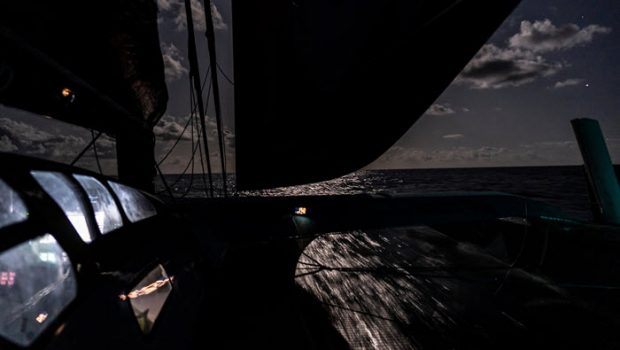


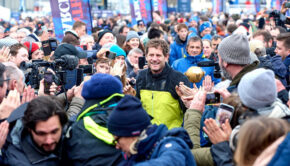
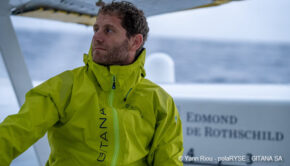
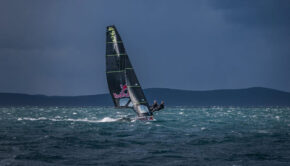
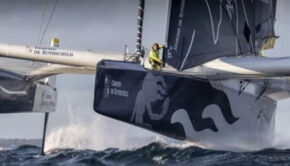
 We’ll keep your information safe.
We’ll keep your information safe.